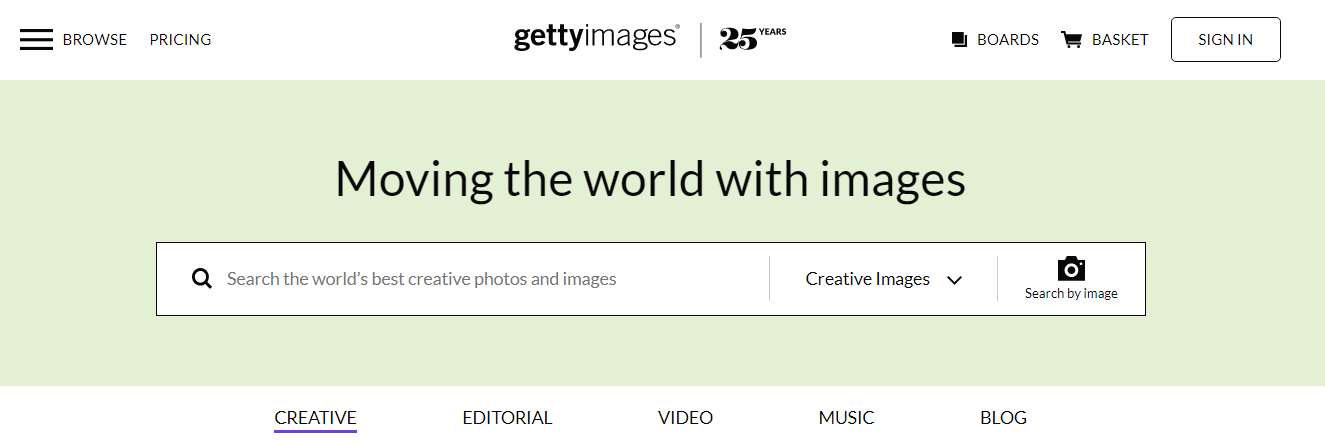If you’re passionate about photography and want to turn your hobby into a source of income, Getty Images is a fantastic platform to consider. With millions of users searching for high-quality images, your photos have a chance to shine. Whether you specialize in landscapes, portraits, or abstract art, the potential for success is immense. In this post, we’ll guide you through the essentials of selling your photos on Getty Images, so you can reach a wider audience and earn from your creative talents.
Understanding the Getty Images Platform

Navigating the Getty Images platform can feel overwhelming at first, but once you get the hang of it, it’s a breeze! Let’s break down some key aspects that will help you understand how to make the most of your experience.
1. Types of Content Accepted
Getty Images primarily focuses on high-quality, professional-grade images. They accept various types of content, including:
- Stock photography
- Editorial images
- Illustrations
- Video footage
It’s crucial to understand which category your work fits into, as different types may have varying submission requirements and market potential.
2. Submission Process
To get started, you’ll need to create an account and submit your portfolio. Here’s a simple breakdown of the submission process:
- Create an Account: Visit the Getty Images website and sign up.
- Portfolio Submission: Upload your best images. Aim for diversity in style and subject matter.
- Review Period: Getty’s team will review your submissions. This can take some time, so be patient!
- Approval Notification: You’ll receive an email about whether your photos have been accepted.
3. Licensing Models
Getty Images operates on two primary licensing models:
- Rights Managed (RM): This type allows buyers to purchase rights for specific uses, often at a premium price.
- Royalty-Free (RF): Buyers pay a one-time fee for broader usage rights, typically resulting in more sales but lower individual prices.
Understanding these models will help you price your work appropriately and attract the right buyers.
4. Marketing Your Photos
Once your images are live, the next step is to market them effectively. Here are some strategies:
- Use Keywords: Use relevant keywords in your descriptions to improve searchability.
- Engage on Social Media: Share your work on platforms like Instagram and Facebook to reach a wider audience.
- Join Photography Groups: Participate in online communities to get feedback and promote your images.
In essence, understanding the Getty Images platform is about knowing what they accept, how to submit your work, and marketing your photos effectively. With dedication and creativity, you can turn your photography into a successful venture!
Also Read This: Getty Stock Photos Pricing Explained
3. Preparing Your Photos for Submission

So, you've captured stunning images, and you're ready to share them with the world through Getty Images. But before you hit that upload button, let’s chat about how to prepare your photos for submission. This first step is crucial to ensure your hard work gets noticed!
Editing Your Images
The first step is editing your photos. Make sure your images are crisp, clear, and perfectly composed. Use software like Adobe Lightroom or Photoshop to enhance colors, adjust exposure, and crop out any distractions. Remember, less is often more; you want your images to shine without over-editing. A good rule of thumb is to keep your edits natural, as overly processed photos can turn off potential buyers.
File Format and Size
Getty Images prefers high-quality JPEG files for submissions. Ensure your images are at least 4,000 pixels on the longest side. This size ensures that your photos can be printed in high resolution without losing detail. If you’re unsure about the sizing, it’s always a good idea to check Getty’s specific submission guidelines for the most up-to-date requirements.
Check for Technical Specifications
- Ensure there are no technical issues, such as visible noise or distortion.
- Make sure your images are in focus and properly exposed.
- Remove any unwanted distractions or objects from your photos.
Incorporating Model and Property Releases
If your photos feature people or recognizable private property, remember to get model or property releases signed. This legal documentation protects you and allows potential buyers to use your images without any issues. Even if you think your photo looks fantastic, without proper releases, you could miss out on sales!
Lastly, review your images one last time before submission. Take a step back and look at each photo critically. Ask yourself: Does this photo tell a story? Is it visually appealing? If the answer is yes, you're ready to move on to the next step!
Also Read This: Getty Images vs Adobe Stock: Comparing Two Prominent Stock Image Providers
4. Optimizing Your Metadata for Better Visibility

Now that your photos are prepped and ready, let’s talk about metadata. This might sound technical, but don’t worry! Optimizing your metadata is crucial for getting your images seen by the right audience. Think of metadata as the ‘story’ of your photo; it helps buyers find exactly what they’re looking for.
Use Descriptive Titles
Your title should be catchy yet informative. Use keywords that describe the photo while also enticing potential buyers. For instance, instead of just “Sunset,” you could use “Vibrant Sunset Over a Tranquil Beach.” This gives a better idea of what the image conveys and helps with search visibility.
Craft Compelling Descriptions
In addition to titles, your descriptions play a vital role. Write a few sentences that tell the story behind the image. Mention the location, the mood, and any unique elements that stand out. For example:
“Captured during golden hour, this image features a stunning sunset illuminating the waves crashing on a serene beach, perfect for travel blogs or relaxation campaigns.”
Utilizing Relevant Keywords
Keywords are the backbone of your metadata. They help your photos show up in search results. Think about what terms buyers might use to search for your images. Include both broad and specific keywords. For example:
- Broad Keywords: beach, sunset, nature
- Specific Keywords: tranquil beach sunset, golden hour, waves at sunset
Make sure to incorporate these keywords naturally into your titles and descriptions, but avoid keyword stuffing. You want your metadata to read smoothly and make sense.
Categories and Tags
Don’t forget to select relevant categories and tags when submitting your photo. This helps buyers narrow down their searches. Categories could include things like “Travel,” “Nature,” or “Lifestyle.” Tags can be more specific, like “waves,” “sunset,” or “beach vacation.” The right combination will significantly enhance your visibility.
In summary, optimizing your metadata is all about making your photos more discoverable. By taking the time to craft thoughtful titles, descriptions, and keywords, you’ll give your images the best chance to shine on Getty Images!
Also Read This: How Imago Images Distinguishes Itself from Leading Stock Photo Websites
5. Tips for Creating High-Quality Stock Images
Creating high-quality stock images isn’t just about having a fancy camera; it’s about understanding your subject, lighting, and composition. Here are some practical tips to help you elevate your stock photography game:
- Invest in Good Equipment: While you don’t need to break the bank, a decent camera and lens can make a significant difference. Consider using a DSLR or mirrorless camera with a versatile lens that allows for different types of shots.
- Focus on Composition: A well-composed image stands out. Use the rule of thirds, leading lines, and symmetry to create visually pleasing photos. Remember, sometimes less is more.
- Natural Light is Your Friend: Whenever possible, shoot in natural light. The golden hour—just after sunrise or before sunset—provides warm, soft lighting that can make your images pop.
- Pay Attention to Background: A cluttered background can distract from your subject. Make sure the background complements your main focus and enhances the overall image.
- Edit Thoughtfully: Post-processing can improve your images, but avoid over-editing. Aim for a natural look that enhances colors and sharpness without making the photo appear unrealistic.
Additionally, consider the types of images that sell well on stock sites. Think about:
- Conceptual images that tell a story
- Trendy lifestyle shots
- High-quality nature and landscape photos
- Images that depict diversity and inclusivity
Finally, don't forget to consistently practice and review your work. Look at successful photographers on Getty Images to inspire your style and approach. Remember, every shoot is a learning experience!
Also Read This: How to Purchase a Digital License for Getty Images: A Step-by-Step Guide
6. Understanding Getty Images Licensing Options
When it comes to selling your photos on Getty Images, understanding licensing options is crucial. Getty offers several types of licenses, and knowing the differences can impact your sales significantly.
The two primary licensing models are:
- Royalty-Free (RF): With RF licensing, customers pay a one-time fee to use your image in various ways, without needing to pay you royalties from each use. This option is popular because it allows more flexibility for the buyer. However, it also means you may sell your image multiple times, affecting exclusivity.
- Rights Managed (RM): RM licensing is more restrictive. Buyers pay based on specific usage, such as the duration, geographical area, and size of the audience. While this model can yield higher fees for exclusive images, you must keep track of how and where your images are used.
Additionally, Getty Images sometimes offers:
- Editorial Use Only: These images can be used for newsworthy or educational purposes, and they often don’t require model releases.
- Extended Licensing: This grants buyers additional rights, such as using your images for merchandise or advertising, but comes at a higher price point.
Understanding these options helps you set realistic expectations for your earnings and how you want your work to be used. Make sure to read the fine print on licensing agreements to safeguard your rights as a photographer. After all, knowledge is power in the world of stock photography!
Also Read This: How to Download Watermarked Photos on Getty: How to Access Preview Images Legally
7. Marketing Your Photos on Getty Images
When it comes to selling your photos on Getty Images, marketing is half the battle. You may have stunning images, but without effective promotion, they might sit unnoticed in the vast library. Here’s how you can get the word out and boost your visibility:
Leverage Social Media: Social media platforms like Instagram, Facebook, and Pinterest are fantastic for showcasing your photography. Create dedicated pages or profiles where you can share your photos, tell the stories behind them, and engage with potential buyers. Use relevant hashtags and geotags to increase your reach. For instance, if you specialize in wildlife photography, tag your posts with hashtags like #WildlifePhotography or #NatureLovers.
Engage with Photography Communities: Join photography forums and online communities, such as 500px or Flickr. Share your work, ask for feedback, and connect with other photographers. Participating in discussions can help you build a network that may lead to more sales. Consider also attending local photography meetups or workshops to expand your connections in person.
Collaborate with Bloggers and Influencers: Reach out to bloggers or influencers who align with your photo themes. They can help promote your work to their followers, sometimes in exchange for collaboration or a fee. For example, if you shoot travel photography, collaborating with travel bloggers can give your photos more exposure.
Utilize Email Marketing: If you have an existing following, consider sending out newsletters showcasing your latest work on Getty Images. Include links to your photos, special projects, or upcoming exhibitions. This not only keeps your audience engaged but also drives traffic directly to your Getty portfolio.
Optimize Your Getty Images Portfolio: Ensure that your portfolio on Getty Images is appealing and well-organized. Use clear, descriptive titles and tags for your photos. A well-optimized portfolio makes it easier for buyers to find your images when searching for specific themes.
In essence, marketing your photos on Getty Images is about creating connections and being proactive. The more effort you put into promoting your work, the higher your chances of making successful sales.
8. Tracking Your Sales and Performance
Once you’ve set up your portfolio and started marketing your photos, it’s crucial to track your sales and performance to gauge your success and refine your strategy. Here’s how to effectively monitor your progress:
Utilize Getty's Analytics Tools: Getty Images provides contributors with access to a dashboard where you can view your sales data. This includes information like the number of downloads, earnings, and the performance of individual images. Regularly reviewing this data helps you understand which types of photos are resonating with buyers.
Set Specific Goals: Establish clear goals, such as a target number of sales per month or a specific income goal. This provides a benchmark against which you can measure your progress. For example, if you aim to sell 50 images in three months, you can adjust your marketing efforts based on your performance to meet this goal.
Analyze Trends: Pay attention to trends in the market. Are certain themes or styles gaining popularity? If you notice that lifestyle photos are selling better than landscapes, consider focusing more on that genre. This not only keeps your portfolio relevant but can significantly boost your sales.
Gather Feedback: Don’t hesitate to ask for feedback from buyers or fellow photographers. Constructive criticism can help you improve your work and marketing strategies. You might find that a simple tweak in your presentation can lead to more sales.
Adjust Your Strategy: Based on the data you collect, make informed decisions about your photography and marketing approach. If certain images aren't selling well, consider reworking their titles or tags, or promoting them in different ways.
By actively tracking your sales and performance, you can continually refine your approach, ensuring that you’re not just selling photos, but selling the right photos effectively.
 admin
admin








